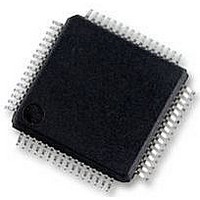P89LPC9401FBD NXP Semiconductors, P89LPC9401FBD Datasheet - Page 26

P89LPC9401FBD
Manufacturer Part Number
P89LPC9401FBD
Description
IC, MCU 8BIT 80C51, LCD DRIVER, SMD
Manufacturer
NXP Semiconductors
Datasheet
1.P89LPC9401FBD551.pdf
(59 pages)
Specifications of P89LPC9401FBD
Controller Family/series
(8051) 8052
Core Size
8bit
No. Of I/o's
23
Program Memory Size
8KB
Ram Memory Size
256Byte
Cpu Speed
18MHz
Oscillator Type
External, Internal
No. Of Timers
4
No.
RoHS Compliant
Available stocks
Company
Part Number
Manufacturer
Quantity
Price
Part Number:
P89LPC9401FBD
Manufacturer:
NXP/恩智浦
Quantity:
20 000
Company:
Part Number:
P89LPC9401FBD,551
Manufacturer:
NXP Semiconductors
Quantity:
10 000
Company:
Part Number:
P89LPC9401FBD,557
Manufacturer:
NXP Semiconductors
Quantity:
10 000
Company:
Part Number:
P89LPC9401FBDЈ¬551
Manufacturer:
NXP
Quantity:
3 048
Philips Semiconductors
P89LPC9401_1
Preliminary data sheet
7.17.5 Mode 6
7.17.6 Timer overflow toggle output
7.19.1 Mode 0
7.19.2 Mode 1
7.19.3 Mode 2
7.18 RTC/system timer
7.19 UART
In this mode, the corresponding timer can be changed to a PWM with a full period of
256 timer clocks.
Timers 0 and 1 can be configured to automatically toggle a port output whenever a timer
overflow occurs. The same device pins that are used for the T0 and T1 count inputs are
also used for the timer toggle outputs. The port outputs will be a logic 1 prior to the first
timer overflow when this mode is turned on.
The P89LPC9401 has a simple RTC that allows a user to continue running an accurate
timer while the rest of the device is powered-down. The RTC can be a wake-up or an
interrupt source. The RTC is a 23-bit down counter comprised of a 7-bit prescaler and a
16-bit loadable down counter. When it reaches all logic 0s, the counter will be reloaded
again and the RTCF flag will be set. The clock source for this counter can be either the
CCLK or the XTAL oscillator, provided that the XTAL oscillator is not being used as the
CPU clock. If the XTAL oscillator is used as the CPU clock, then the RTC will use CCLK as
its clock source. Only power-on reset will reset the RTC and its associated SFRs to the
default state.
The P89LPC9401 has an enhanced UART that is compatible with the conventional 80C51
UART except that Timer 2 overflow cannot be used as a baud rate source. The
P89LPC9401 does include an independent Baud Rate Generator. The baud rate can be
selected from the oscillator (divided by a constant), Timer 1 overflow, or the independent
Baud Rate Generator. In addition to the baud rate generation, enhancements over the
standard 80C51 UART include Framing Error detection, automatic address recognition,
selectable double buffering and several interrupt options. The UART can be operated in
four modes: shift register, 8-bit UART, 9-bit UART, and CPU clock/32 or CPU clock/16.
Serial data enters and exits through RXD. TXD outputs the shift clock. 8 bits are
transmitted or received, LSB first. The baud rate is fixed at
frequency.
10 bits are transmitted (through TXD) or received (through RXD): a start bit (logic 0),
8 data bits (LSB first), and a stop bit (logic 1). When data is received, the stop bit is stored
in RB8 in Special Function Register SCON. The baud rate is variable and is determined
by the Timer 1 overflow rate or the Baud Rate Generator (described in
“Baud rate generator and
11 bits are transmitted (through TXD) or received (through RXD): start bit (logic 0), 8 data
bits (LSB first), a programmable 9
transmitted, the 9
Or, for example, the parity bit (P, in the PSW) could be moved into TB8. When data is
8-bit two-clock 80C51 microcontroller with 32 segment
th
data bit (TB8 in SCON) can be assigned the value of logic 0 or logic 1.
Rev. 01 — 5 September 2005
selection”).
th
data bit, and a stop bit (logic 1). When data is
© Koninklijke Philips Electronics N.V. 2005. All rights reserved.
1
16
P89LPC9401
of the CPU clock
Section 7.19.5
4 LCD driver
26 of 59
















